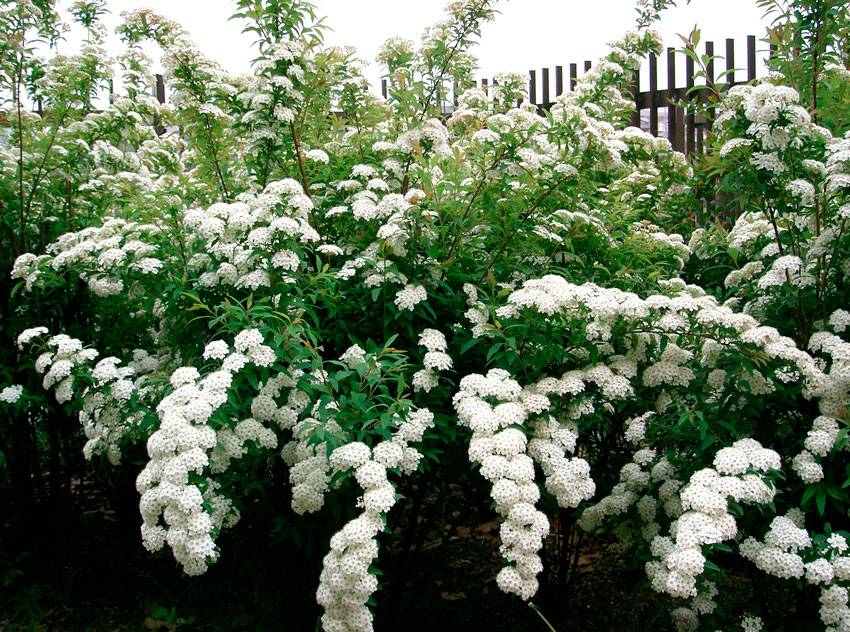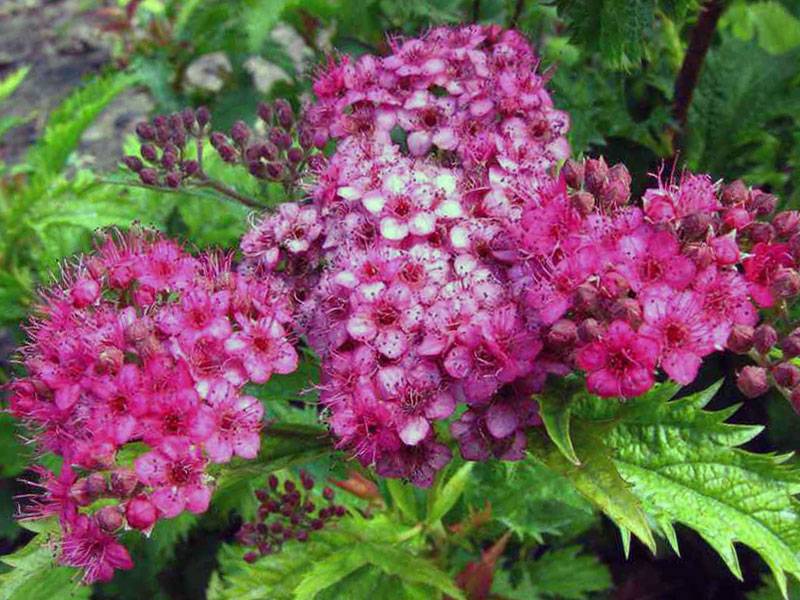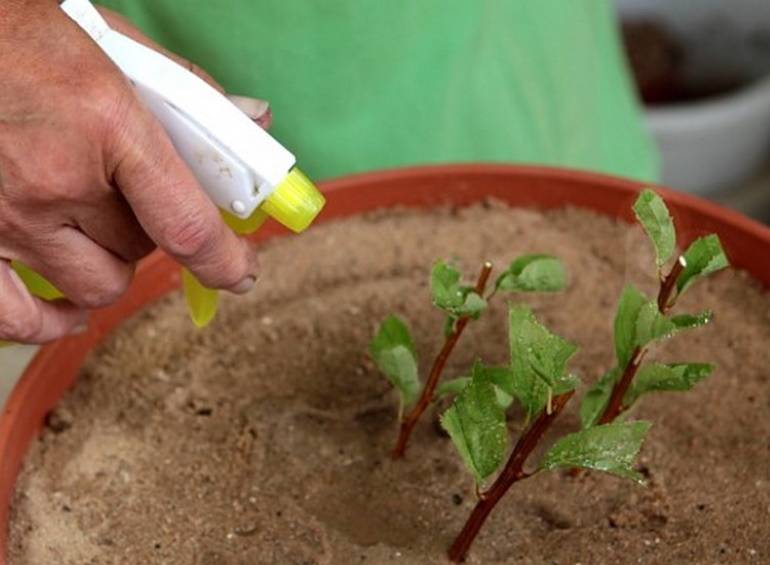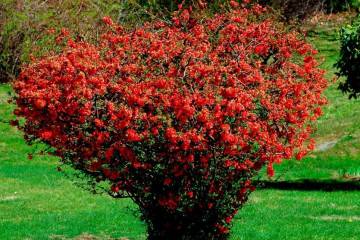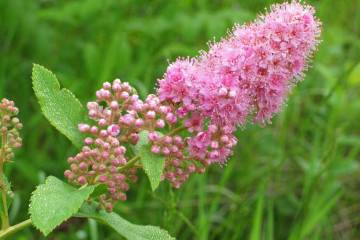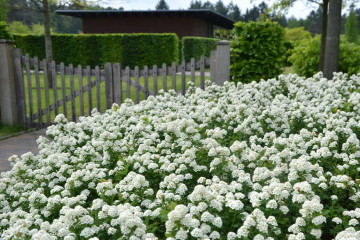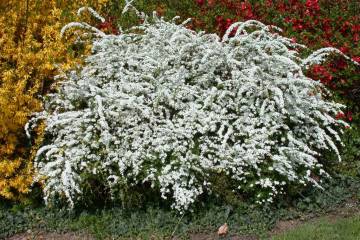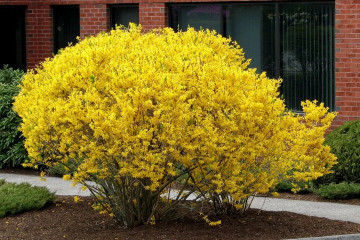Japanese spirea shrub or bride - description
Content:
Spirea is a shrub that attracts attention with its magnificent flowering, a varied palette of colors of inflorescences and leaves, the size and shape of the bush, endurance and unpretentiousness. Such a decorative bush will be a decoration for any type of landscaping of a personal plot or park area.
The origin and appearance of the plant
Spirea is a representative of the genus of decorative deciduous shrubs from the Pink family. It got its name from the ancient Greek word “Speira”, which means “bend” in Russian, because of the unique flexibility of the plant's shoots.
A perennial shrub of spirea is widespread in the forest and forest-steppe zones of the temperate zone and on the rocky terrain of the Alps, the Himalayas, it is found near Mexico. The shrub grows in height from 0.5 m to 2.5 m, depending on the species. The shape of the bush can be varied: spherical, weeping, creeping, etc.
In some species, the foliage remains green all the time, in others, by autumn, the leaf pigmentation changes to red, orange, yellow.
The bush blooms for the first time in the second or third year after planting a young plant. Small numerous flowers form inflorescences of various shapes (corymbose, spike-shaped, paniculate and pyramidal). Some crops have single flowers.
Spirea flowers have a different color: from white to crimson. It is interesting not only the location of the inflorescences, but also the timing of flowering.
Variety of species
Some members of the genus are more popular, others less. In terms of the timing of flowering, all spireas are divided into spring-flowering and summer-flowering.
Spring flowering varieties
These shrubs bloom very early. A distinctive feature of all species of this group are flowers of all shades of white. Inflorescences appear on last year's shoots.
The following types are popular among florists:
- Wangutta (Spiraea x vanhouttei). A large bush with strong spreading branches reaches a height of 2 m. Popularly, this spirea bush is called "bride". Shoots are covered with toothed dark green leaves, the reverse side is gray. In autumn, the leaves change their pigmentation to red or orange. The bride shrub is strewn with hemispherical snow-white inflorescences, blooming from mid-June, sometimes there is a second flowering in August. Bride - a plant obtained from 2 types of shrubs;
- oak-leaved (Spiraea chamaedryfolia). Erect bush 2 m high. Long shoots under the weight of inflorescences lean to the ground. The crown has a rounded shape. White hemispherical inflorescences begin to bloom in early May;
- nippon (Spiraea nipponica). The homeland of the plant is Japan, about. Honshu. Globular shrub Japanese spirea reaches 2 m. It blooms with corymbose inflorescences from the beginning of June. It attracts attention with small yellow-green flowers, which have a purple color in the bud;
- Thunberg (Spiraea thunbergii). In natural conditions, it grows on the Chinese mountain slopes and valleys, the height of the bush is 1.5 m.The branchy shrub looks decorative in autumn, when the leaves acquire an orange color. The inflorescences of the Thunberg bush are represented by sessile umbrellas, consisting of small white flowers. Flowering occurs in May;
- crenate (Spiraea crenata). Distributed in the southeast of Russia and Western Europe. The plant is under the protection of reserves. A low shrub (about 1 m tall) with a loose crown, it has a crenate leaf edge with 3 veins. Shield-shaped inflorescences are collected from flowers of a cream shade. The variety blooms in June;
- gray (Spiraea x cinerea). Sprawling 2-meter shrub with gray-green leaves. Snow-white flowers are collected in thyroid inflorescences. The gray spirea shrub blooms in May. Due to its compactness and abundant flowering, the plant is widely used for decorative purposes.
Summer flowering varieties
These plants differ from spring-flowering plants in that their inflorescences appear on the tops of young runs. Last year's shoots dry up over time.
Spirea willow (Spiraea salicifolia) is an upright 2-meter bush with red-brown shoots. Flowers are white or pink, collected in pyramidal-paniculate inflorescences. Habitat - Siberia, Europe, North America, Japan and China.
White-flowered spirea (Spiraea albiflora) is notable for the fact that it blooms in the second half of summer. On a small shrub 0.5-0.8 m high, white fragrant flowers appear in mid-July. Inflorescences are flat and large form corymbose panicles.
Japanese spirea (Spiraea japonica) is a beautiful shrub with tomentose-pubescent stems. Plant height 1-1.5 m. Japanese spirea blooms for 45 days with red-pink flowers, collected in paniculate-corymbose inflorescences.
Douglas spirea (Spiraea douglasii) blooms from July to September. Dark pink flowers are collected in apical paniculate-pyramidal inflorescences. The height of the bush is 1.5 m, the shoots are straight red-brown.
Spiraea Bumalda (Spiraea x bumalda) is a low-growing shrub up to 0.8 m high. It is a hybrid form of Japanese and white-flowered spirea. The shrub looks picturesque in autumn, at this time the leaves change color from green to red, purple, yellow. It begins to bloom in July with pale pink flowers.
Billard's spirea (Spiraea x billardii) blooms with bright pink narrow pyramidal-paniculate inflorescences from mid-July. This hybrid variety of spirea, obtained by crossing the Douglas and willow varieties, is 2 m high.
Transplanting a seedling after purchase in open ground
Cloudy September days are suitable for planting a bush. The soil should be well saturated with moisture. In the spring, only summer-flowering species are planted, the main thing is to have time before the leaves bloom.
When buying seedlings, you need to pay attention to the roots so that they are not overdried. Sapling shoots should be flexible with good buds.
For planting, choose sunny areas with loose, air-permeable soil with a sufficient amount of humus. The depth and width of the hole should be 25-30% larger than the root system of the bush.
Before planting a seedling, you need to dig a hole, at the bottom of which the soil is poured, then the plant is installed (always with straightened roots) and covered with an earthen mixture.
Seedlings purchased with a closed root system are watered abundantly after planting, and plants with bare roots are pre-soaked in water with a root growth stimulator.
Reproduction of spirea
Shrub propagation takes place in 3 ways:
- seeds;
- cuttings;
- layering.
Sowing seeds is carried out in wide containers filled with peat and leafy soil. The containers with crops are covered with foil, and after 8-10 days the first shoots appear. After 2-3 months, the seedlings are transplanted to the site (preferably in the shade) and be sure to pinch the tops. Water and cover with a thin layer of mulch.
After 3-4 years of regular watering and loosening, young spireas bloom.
The bush is propagated by layering in the spring. During this period, the lower shoots are pressed to the ground, securing them with small forks, and sprinkled with earth. Cover with foliage for the winter. Rooting occurs by the next spring, then the shoot can be separated from the mother bush and transplanted to a permanent place of growth.
Cutting is the most common way to propagate a shrub. Cuttings are harvested in spring and summer after the end of active growth.
Prepared cuttings are placed in containers with river sand and peat, arranging 4-5 watering times. The next spring, cuttings with roots are transferred to the garden for growing or immediately planted in a permanent habitat.
Plant care in the garden
Watering should be moderate, without moisture stagnation. The amount of watering is regulated depending on the weather conditions. After the procedure, it is necessary to loosen and weed the soil from weeds.
For active development and abundant flowering, the plant is fed with fertilizers containing nitrogen, phosphorus and potassium. This procedure is performed in early spring.
Sanitary pruning of old and frozen branches is carried out with an early vein. Once every 3-4 years, the rejuvenation of the bush is necessary, for which all branches are cut off almost to the stump.
It is easy to prepare such a plant for winter, since almost all varieties have good winter hardiness. Additionally, the root system can be covered with a layer of fallen leaves.
Spirea shrub is used as a decorative component. In landscape design, it looks good in lush hedges, group compositions, or as an independent part, decorating, for example, a gate. Unpretentious to care for and easy enough to cultivate, the plant is suitable for both novice gardeners and experienced ones.
